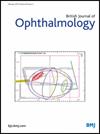Characterisation and prevalence of inherited retinal diseases in the Finnish population reveals enrichment of population-specific phenotypes and causative variants.
IF 3.5
2区 医学
Q1 OPHTHALMOLOGY
引用次数: 0
Abstract
AIMS This study aims to assess clinical and genetic characteristics as well as the prevalence of inherited retinal dystrophies (IRD) and their subphenotypes in the Finnish founder population. METHODS A retrospective analysis of clinical and genetic data from Northern Finnish patients diagnosed with IRD between 1996 and 2023 at Oulu University Hospital, Finland, was conducted. RESULTS The cohort comprised 582 patients with IRD, categorised into 16 different subphenotypes. Pathogenic or likely pathogenic variants explaining IRD were identified in 36% (n=210/582) of all patients and 80% (n=210/261) of genetically tested patients with IRD. Diagnostic yields varied between different IRD subphenotypes. The genetic aetiology was most commonly confirmed in X-linked retinoschisis, severe early childhood-onset retinal dystrophy, congenital stationary night blindness and choroideremia. The lowest rates of causative variant identification were observed in cone or cone-rod dystrophy and macular dystrophy. In total, 70 pathogenic or likely pathogenic variants were identified across 39 different genes; variants in the FZD4 and RPGR genes were the most prevalent. Over half of the variants were enriched in the Finnish population. The estimated total prevalence of IRDs in Northern Finland was 69.8/100 000 (1:1432). The prevalence of the most common subphenotypes was as follows: retinitis pigmentosa, 25.3/100 000; X-linked retinoschisis, 10.7/100 000; Usher syndrome, 8.9/100 000; choroideremia, 7/100 000 and cone or cone-rod dystrophy, 6/100 000. CONCLUSION The Northern Finnish population exhibits an enrichment of population-specific IRD-associated variants, resulting in a high overall prevalence of IRDs and an increased prevalence of selected retinal subphenotypes, such as retinoschisis, choroideremia and Usher syndrome types 3 and 1.芬兰人群中遗传性视网膜疾病的特征和患病率揭示了人群特异性表型和致病变异的丰富。
目的:本研究旨在评估芬兰创始人群中遗传性视网膜营养不良症(IRD)的临床和遗传特征以及患病率及其亚表型。方法回顾性分析1996年至2023年在芬兰奥卢大学医院诊断为IRD的芬兰北部患者的临床和遗传资料。结果该队列包括582例IRD患者,分为16种不同的亚表型。所有IRD患者中有36% (n=210/582)和80% (n=210/261)的基因检测患者中发现了解释IRD的致病或可能致病变异。诊断产率在不同的IRD亚表型之间存在差异。遗传病因最常见于x连锁视网膜裂、严重的儿童早期发病视网膜营养不良、先天性静止性夜盲症和脉络膜血症。在锥体或锥体杆营养不良和黄斑营养不良中观察到最低的致病变异鉴定率。总共在39个不同的基因中鉴定出70种致病性或可能致病性变异;FZD4和RPGR基因变异最为普遍。超过一半的变异在芬兰人中富集。芬兰北部IRDs的估计总患病率为69.8/10万(1:1432)。最常见的亚表型患病率为:视网膜色素变性,25.3/10万;x连锁视网膜裂,10.7/10万;Usher综合征8.9/10万;脉络膜缺乏占7/10万,锥体或锥杆营养不良占6/10万。结论:芬兰北部人群显示出人群特异性ird相关变异的富集,导致ird的总体患病率较高,并且某些视网膜亚表型(如视网膜裂、脉络膜血症和Usher综合征3型和1型)的患病率增加。
本文章由计算机程序翻译,如有差异,请以英文原文为准。
求助全文
约1分钟内获得全文
求助全文
来源期刊
CiteScore
10.30
自引率
2.40%
发文量
213
审稿时长
3-6 weeks
期刊介绍:
The British Journal of Ophthalmology (BJO) is an international peer-reviewed journal for ophthalmologists and visual science specialists. BJO publishes clinical investigations, clinical observations, and clinically relevant laboratory investigations related to ophthalmology. It also provides major reviews and also publishes manuscripts covering regional issues in a global context.

 求助内容:
求助内容: 应助结果提醒方式:
应助结果提醒方式:


